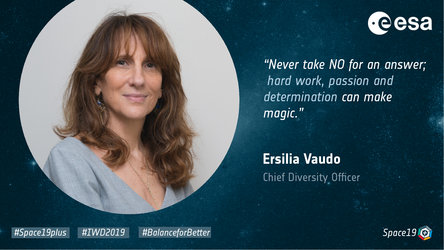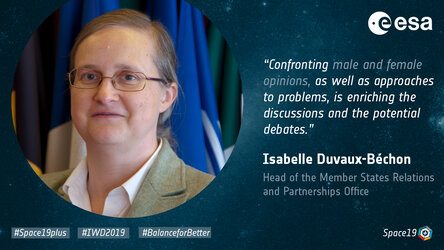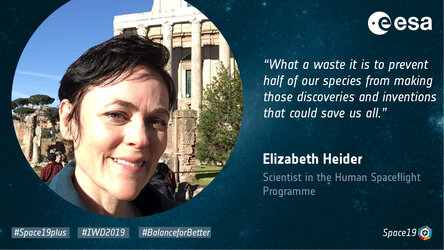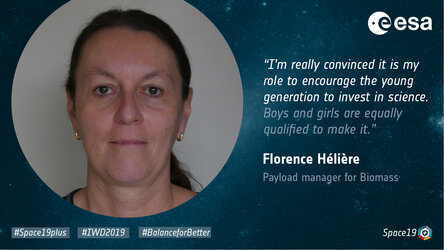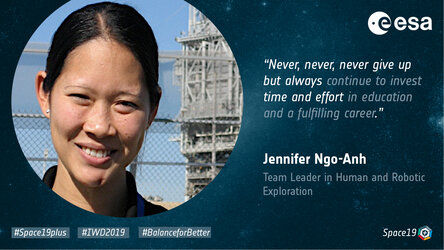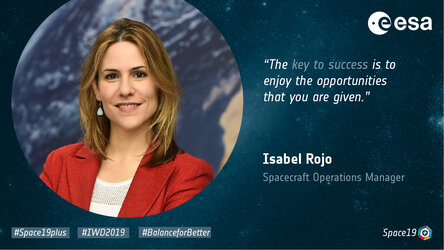Ersilia Vaudo, Chief Diversity Officer for ESA
Please give a brief description of your duties at ESA.
I have been working at ESA since 1991 and have held several positions during my career, including in strategy and international relations. I also worked as coordinator of science and human spaceflight activities and had responsibility as Executive Secretary of the Science and Technology Advisory Group on Exploration. I spent four years at the ESA Office in Washington DC, in charge of relations with NASA and US stakeholders. Since April 2017, I have been Chief Diversity Officer. My role is to support the Director General in proposing actions that enhance the Agency’s wealth of diversity, while striving to ensure inclusiveness so that the values and objectives pursued through those actions become an inherent feature of the Agency’s policies and business practices.
What inspired you to pursue a career in science and engineering and what motivated you to join ESA specifically?
At the age of 17, I was very interested in philosophy and literature, but also highly attracted to science. I finally chose physics as I was seeking the challenge of stretching my perspective beyond the borders of experience, and wanted to be confronted with the mysteries of the unknown around me. I earned a degree in physics, with a specialisation in astrophysics, and I worked in a laboratory at the University “La Sapienza” in Rome on the measurement of the anisotropy of the cosmic microwave background radiation.
Studying physics, and in particular quantum mechanics and general relativity, has presented a unique opportunity for me to stretch my mind, triggering a personal transformation and enhancing that sense of curiosity and astonishment that is inherent to science. I also gained a strong sense of empowerment. We are no more than a little spark, in an indifferent and silent universe. However, we enjoy this great privilege of self-consciousness, wondering about the space around us, asking ourselves questions and striving for answers.
The European Space Agency has been the ideal place to nurture my interest in space and to reconcile my passions, culminating in the great experience of working in an international environment permeated by science and amazement.
Did you encounter gender barriers on your way to becoming a scientist / engineer?
I was born and raised in a small town on the southern Italian coast in a family that has always nurtured a true passion for science (and for the sea). I was particularly fascinated by my mother’s profession. She had a degree in chemistry and biology – quite a rare feature for an Italian woman at that time – and was a real ‘militant’ for science. As an example of her drive, we had in our kitchen different jars containing sugar or salt or other cooking stuff but with a twist: In the spirit of encouraging me and my brothers to learn chemistry, she used to indicate only the chemical formula on the jars’ labels. You can imagine what happened when, at the age of 7, I used many spoons of NaCl (salt), instead of C6H12O6 (yes, sugar!) to prepare the cakes for the school bake sale. This is to say that I was actively encouraged to study science, both by my family and at school.
What progress have you seen in addressing the gender imbalance in your profession through equal-opportunity measures in recent years?
A stronger focus has been put on the subject of gender imbalance, as part of the Director General’s priority of enhancing diversity and inclusiveness at ESA. A number of measurable objectives in terms of female recruitment and representation have been set, and we are already seeing encouraging results. For example, in 2018, the share of women recruited for professional positions has reached 40 percent – a significant increase from 28 percent in 2017. Furthermore, we are currently working on an enhancement of the Young Graduate Trainee (YGT) scheme to increase the Agency’s attractiveness to women in their 30s with some years of working experience.
What are, in your view, three measures that could make a difference in supporting a work-life balance and at the same time equal career opportunities.
- Flexibility in working hours and place, while ensuring with adequate measures that managers don’t unconsciously operate with an ‘out of sight, out of mind’ approach when considering someone’s career prospects, but rather evaluate staff on the basis of objective achievements.
- To balance the ‘time divide’ in terms of time spent at the office, which can negatively affect women, particularly with young babies. As a provocative measure, I would suggest that the electricity is cut off in the buildings at 6 pm. This way, there would be no more evening meetings largely among men staying late in the offices. Everyone will go home at the same time, and can still work from there if necessary.
What advice would you give to a girl or young woman who is considering a career in science and engineering?
Two pieces of advice that I give to girls and young women are: “Never take NO for an answer – hard work, passion and determination can make magic” and, “Don’t be afraid to fail, but fail smart and learn fast from it”. Pursuing a career in a STEM (science, technology, engineering, mathematics) field can be difficult, and there may be many moments of discouragement. However, the emotion and the sense of empowerment that arise from understanding and mastering those subjects are overwhelming.



